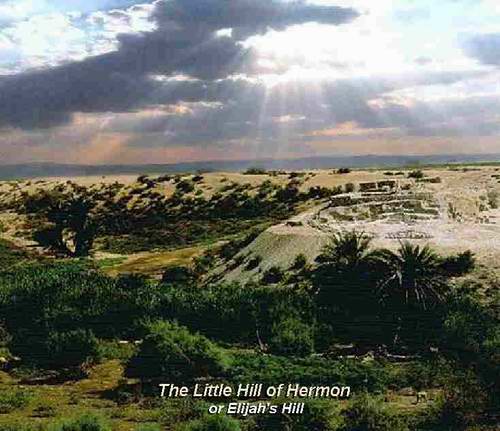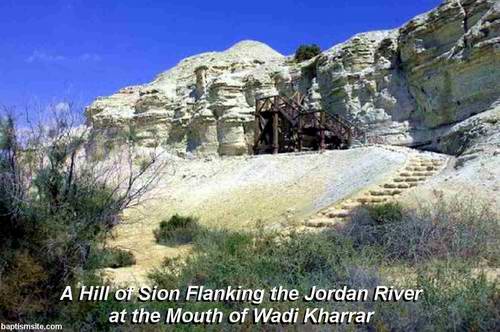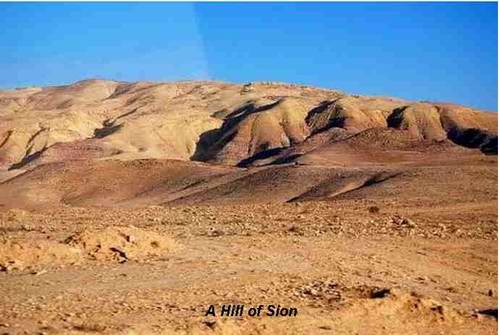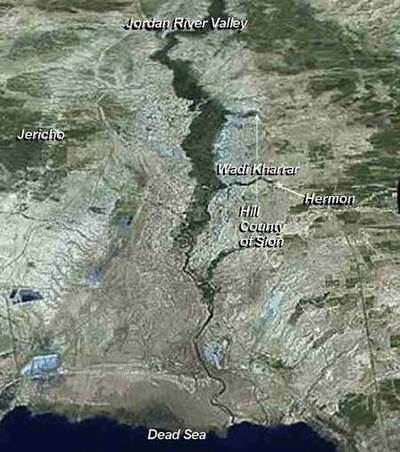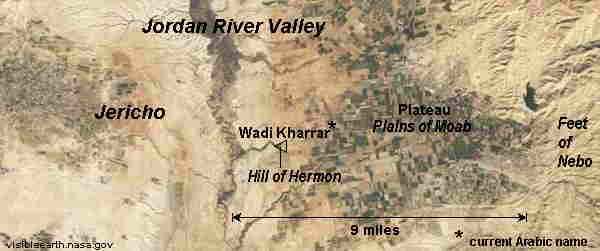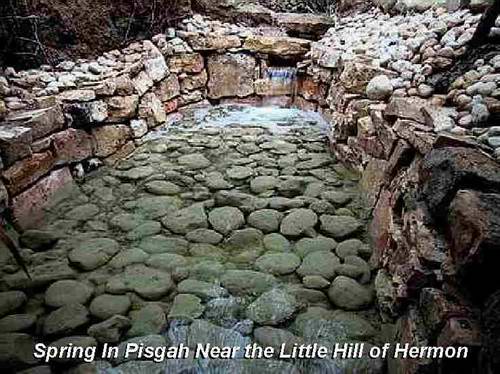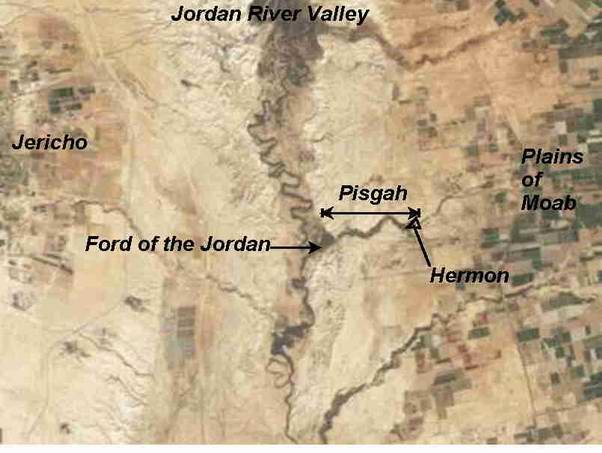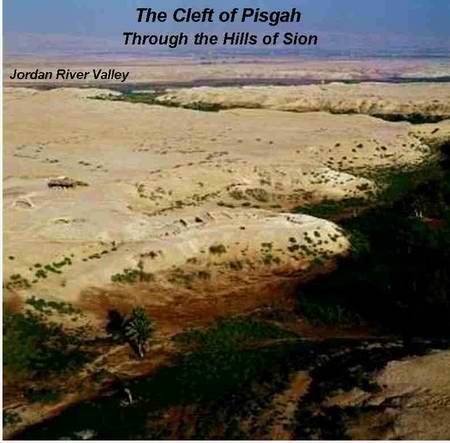|
|
The Series The Anchor of the Soul The Location of Mount Sion and the Real Hermon The Place of Salvation? by Steve Santini
February 2013 But ye are come unto mount Sion, and unto the city of the living
God, the heavenly Jerusalem, and to an innumerable company of
angels Hebrews 12:22 The one section in the Old Testament where Mount Sion appears in the King James translation pinpoints the location to which the faithful are to be taken for the finality of salvation. And they possessed his land, and the land of Og king of Bashan, two kings of the Amorites, which were on this side Jordan toward the sunrising; From Aroer, which is by the bank of the river Arnon, even unto mount Sion, which is Hermon, And all the plain on this side Jordan eastward, even unto the sea of the plain, under the springs of Pisgah. Deuteronomy 4:47-49 In the above section Mount Sion is identified as
Hermon. In the Hebrew language Hermon
means sacred sanctuary set apart for a
designated holy purpose [1] Until
recently, there have been two locations identified as this Hermon that
corresponds to Mt Sion. One is a peak on the high mountain range in southern
Lebanon, just north of the Sea of Galilee. The other is an area in a vale below
the summit of Mount Tabor just six miles east of Nazareth. This second site was
once known as Little Hermon. Neither of
these two sites fits the description given in this fourth chapter of
Deuteronomy. The sea of the plain below the springs of Pisgah is the Dead Sea.
Pisgah has always been identified with Mount Nebo that over looks the plains of
Moab just a bit northeast of the Dead Sea. The Plains of Moab are the location
where Moses and the children of Israel were encamped in the entire account of
the book of Deuteronomy where these verses appear. In
addition, the Hermon in Lebanon was a site where gods that were no gods were
worshipped. This led later writers of scripture to identify this site for Hermon as
Baal-Hermon. Similarly, at the site below the top of Tabor,
on the opposite side of the Jordan River from the description given in
Deuteronomy, those of Israel who refused to believe the prophets once offered
their sacrifices. These facts have led scholars to be skeptical about either
location as the definitive site for Hermon and Mount Sion. When
writing about these early Christian topographical identifications of biblically
named sites, W. G. Mastermar wrote in the International Standard Bible
Encyclopedia of 1939, "It was a period
when Biblical topography was settled in a very arbitrary manner, without any
scientific or critical examination of the evidence, and this tradition once
established remained, like many such traditions, undisputed until very recent
years" After the Roman Empire's destruction of
Jerusalem in 70 AD the name itself and its associations were blotted out
for two Roman generations or 60 years. No writings or mentions of Jerusalem's
name were allowed. The pile of rubble at the foot of the Mount of Olives
remained nameless, as did the region about it until 130 AD when the name of
former Jerusalem was changed to Aelia Capitolina
and the former Iudaea Province to Syria Palaestina. Eastern
Christians and Hebrews were banned from the city. In the Roman
reconstruction, Emperor Hadrian built
a Temple to Aphrodite. When Christianity was made the state religion of Rome in
the fourth century the site became the location for the Church of the Holy
Sepulcher. At this time devout Easterners were again allowed into the city.
During the interim, however, many of the scriptural names and locations had
been forgotten or hidden. It was not until then in this fourth century that
focused attempts were made to re-identify the locations of events in Hebrew and
Christian scriptural history. Over time with scientific methods and
critical examinations of scripture, and of historical writings, corrections have been made to these earlier
designations. Still, from the time of W. G. Mastermar's writing in 1939 until very recently bible students have not had a definitive location for Hermon and Mount Sion. Fortunately, in 1998, the Kingdom of Jordan initiated archeological excavations around, and historical research about, the other side of the Jordan where the Israelites encamped before entering the Promised Land. Up from a ford of the Jordan in this region, through a ravine, in which the Wadi Kharrar flows, researchers have discovered a site once known as Elijah's hill the place where Elijah was taken up in a whirlwind. From the fourth through the sixth centuries and again during the eleventh and twelfth centuries, Christian pilgrims heavily traveled this area with knowledge of Hermon's presence here.
In 530 AD, the Western pilgrim
Theodosius wrote of his pilgrimage to Jerusalem, the Jordan and beyond. He
wrote, "Where my Lord was baptized there is, on the far side of the
Jordan, the 'little hill' called Hermon, where Saint Elijah was taken up". Similarly, the Pilgrim from
Piacenza wrote around 570 AD: "This is the place where Elijah was taken up
(to heaven). In that place is the little hill of Hermon mentioned in the
Psalm. This location appears to be in
harmony with the descriptions in the fourth chapter of Deuteronomy. If it is,
as it appears, then Mount Sion is also in this area. First, the word mount used with Sion in the Hebrew and Greek languages basically means an uplifted area of land.[2] The Hebrew word is
translated in the English bible as mountain,
mount, hill and hill country depending on the biblical context and the
topographical understandings of the purposed regions when the Hebrew texts were
translated. In this new area of discovery
where the little hill of Hermon stands, there is a range of steeply rising
hills running along the eastern side of the Jordan River's course.
This uplifted land elevates
eastward to the Plains of Moab in a span of 2 to 3 miles. Since Hermon is
written of as the same as Mount Sion either this little hill of Hermon is Sion
or this little hill of Hermon is one of the hills in the hill country of Sion.
To the east beginning at the
crest this range of relatively low hills is the 5 to 6 mile wide plateau know
as The Plains of Moab where Israel was encamped before the crossing of the
Jordan. Then at the eastern edge of the plateau Mount Nebo rises abruptly from
the plain.
Even before this recent
discovery, both the other named Hermons have been associated with the Mount of
Transfiguration. From the scripture the association of the two appears correct.
However, based on previous misinformation regarding the location of Hermon
these former locations for the actual Mount of Transfiguration are incorrect.
Scriptural and historical information now point to a hill or mountain in this vicinity east of the Jordan River.
It was in this area on the
other side of the Jordan that both Moses and Elijah disappeared. Reasonably,
the most significant location for their confirming reappearance with Jesus
Christ would be in the locale of their original transformation into the purely
spiritual realm. After the first coming of
Jesus Christ millions of pilgrims have traveled a pilgrimage route from Nebo on
the east, to the Jordan's ford at the foot of Wadi Karrar and many times onward
to Jerusalem in the mountains of Zion directly to the west. In 1173 AD the German monk, Theoderich, wrote that on one night there were 60,000 pilgrims with candles in this area around the Jordan. In 1848 Lieutenant William Lynch led a small expeditionary contingent of US seamen on a scientific expedition down the Jordan River to the Dead Sea. Under a full moon on one spring night, while encamped on the east bank of the Jordan near the ford, Lieutenant Lynch was awakened by a shout to experience the following:[3] "The pilgrims are coming,
get out of the way!.the ground was shaking.we beheld thousands of
torchlights with a dark mass beneath, moving rapidly over the hills.in one
tumultuous and eager throng. In all the wild haste of a disorderly rout, Copts,
and Russians, Poles, Armenians, Greeks, and Syrians, from all parts of Asia,
from Europe, from Africa, and from far-distant America, on they came, men women
and children, of every age and hue, and every variety of costume; talking,
screaming, shouting, in almost every known language under the sun. Along this route there were
about 20 pilgrim
stations that provided rest and sustenance for the pilgrims on their
journeys. These pilgrims knew that there was a connection between the peak of Nebo and Jerusalem.
They also knew that Sion, the place of ultimate salvation written of in the
book of Hebrews, lay below Nebo on the western edge of the Plains of Moab down
through which a ravine cuts to the ford across the Jordan. This gently sloping
ravine now named Wadi Kharrar is the Pisgah written of in association with
Hermon and Sion in Deuteronomy chapter four. Even unto mount Sion, which is Hermon, and all the plain on this side Jordan eastward, even unto the sea of the plain, under the springs of Pisgah. Deuteronomy 4:48b-49 There
are five springs that feed into the top of this wadi as the springs of Pisgah
written of in the above verse.
Pilgrims made their way down
the ravine that was cut through the hills to the ford of the Jordan at the
ravines foot where Jesus was baptized. They traveled this way as did the
fathers of old like Abraham and the early saints like Melchisedec. This route
was the route from the Plains of Moab for the priests bearing the Ark of the
Covenant in leadership of the children of Israel for their crossing of the
Jordan. (Joshua 3) It is most certainly the way John the Baptist, Jesus Christ
and his apostles traveled.
In 129 AD the Roman Emperor Hadrian constructed a Roman road from Heshbon on the ancient north-south Kings Highway about 17 miles east of Pisgah to connect to Jericho across the Jordan. This road was built upon the ancient spice route over the northern flank of Nebo, across the Plains of Moab, down Pisgah, across the Jordan ford where Jesus had once been baptized, onward to Jericho and then up to Jerusalem.[4] The meaning of Pisgah is appropriate for this wadi as it cuts through the hills of Sion as it descends to the Jordan. Pisgah in Hebrew means cleft or cut as letters or symbols chiseled into rock. [5]
The apostle Paul wrote a three chapter section In letter to the Romans on the salvation of the "all Israel" comprised of Jews of faith and grafted in Gentiles based on faith. In the section he wrote of Sion twice. In the closing of this section he wrote: And so all Israel shall be saved: as it is written, There shall come out of Sion the Deliverer, and shall turn away ungodliness from Jacob: Romans11:26 Jesus, the Christ, did come out of Sion. First he came out of Sion to be baptized by John the Baptist as the Savior for his kinsmen, bloodline Israel. Then he came out of Sion shortly after his transfiguration on the holy mount with Elijah and Moses. This time though he came out of Sion as the Christ, the Son of God for the salvation of the whole world. So Jesus, the Christ, did come out of Sion twice and he will again come out of Sion. The next time it will be with his fulfilled one body comprised of the saints and the resurrected first fruits of faithful in Christ Jesus, together, for the eventual salvation of all other men. There is another Old Testament verse that confirms
this location beyond the Jordan as Hermon and subsequently Sion. The Pilgrim from Piacenza also wrote this of the area: At the foot of
the mountain at seven o'clock in the morning, a cloud forms over the river,
arriving over Jerusalem at sunrise, above the basilica on Zion, the basilica at
Christ's Tomb and basilica of Saint Mary and Saint Sophia (once the Praetorium
where Christ's case was heard). Above these places the dew comes down like
showers, and sick people collect it. In the hospices all the dishes are cooked
in it, and in the places where this dew falls many diseases are cured. For this
is the dew of which the Psalmist signs, 'it is as if the dew of Hermon were
falling on Mount Zion Psalm 133 states: Behold, how good
and how pleasant it is for brethren to dwell together in unity! It is like the
precious ointment upon the head, that ran down upon the beard, even Aaron's
beard: that went down to the skirts of his garments; As the dew of
Hermon, and as the dew that descended upon the mountains of Zion: for there the
LORD commanded the blessing, even life for evermore. The dew from the distant
mountains of Lebanon to the north or from Mount Tabor does not fall on
Jerusalem in the mountains of Zion. The rising moisture from the Jordan and
Dead Sea to the east of Jerusalem is caught by the prevailing morning breezes and does
fall on Jerusalem as dew, especially in late summer and early fall. So here across the Jordan
about 30 miles directly east of Jerusalem lies Sion the land to which the
wedding guest will be taken by the holy angels for the fulfillment of the revelation of
the great mystery given to the apostle Paul by the ascended Lord Jesus Christ. From The Series Previous Article Searching for the Place
of Salvation Next Article [1] The New Strong's Expanded Exhaustive Concordance of the Bible, Stong, J., Thomas Nelson Publishers, Nashville, 2001 # 2768 & 2763 The Analytical Hebrew and Chaldee Lexicon, Davidson, B., Hendrickson Publishers, Peabody, MA, 2000, p.275-6 [2] The New Strong's Expanded Exhaustive Concordance of the Bible, Stong, J., Thomas Nelson Publishers, Nashville, 2001 #2022 [3] Bitter Waters: America's Forgotten Naval Mission to the Dead Sea, Bain, D. H., The Overlook Press. NY 2011 p. 191-2 [4] This route was the quickest and most secure route from Jerusalem to Damascus. It is most likely the route Saul of Tarsus, (later to be known as the apostle Paul), took when the Sanhedrin commissioned him to go to Damascus and take captive those Jews in Damascus who had believed in Jesus Christ. As such it would have been along this route to Damascus that the ascended Lord Jesus Christ forced down, blinded and spoke to Paul.(Acts 9:1-9) In addition, at the time of Jesus and Paul, all land east of the Jordan River was known as Arabia. Paul wrote that a short time after his conversion he went alone into Arabia for three years.(Galatians 1:11-18) The area just east of the Jordan was also known as a place for reclusive contemplation. Ancient hermit caves still exist along the steep hillside bordering the eastern Jordan in the area of Pisgah and along the sides of the cleft of Pisgah itself. [5] The New Strong's Expanded Exhaustive Concordance of the Bible, Stong, J., Thomas Nelson Publishers, Nashville, 2001 # 6449 & 6448 The Analytical Hebrew and Chaldee Lexicon, Davidson, B., Hendrickson Publishers, Peabody, MA, 2000, p.628, 629 |
